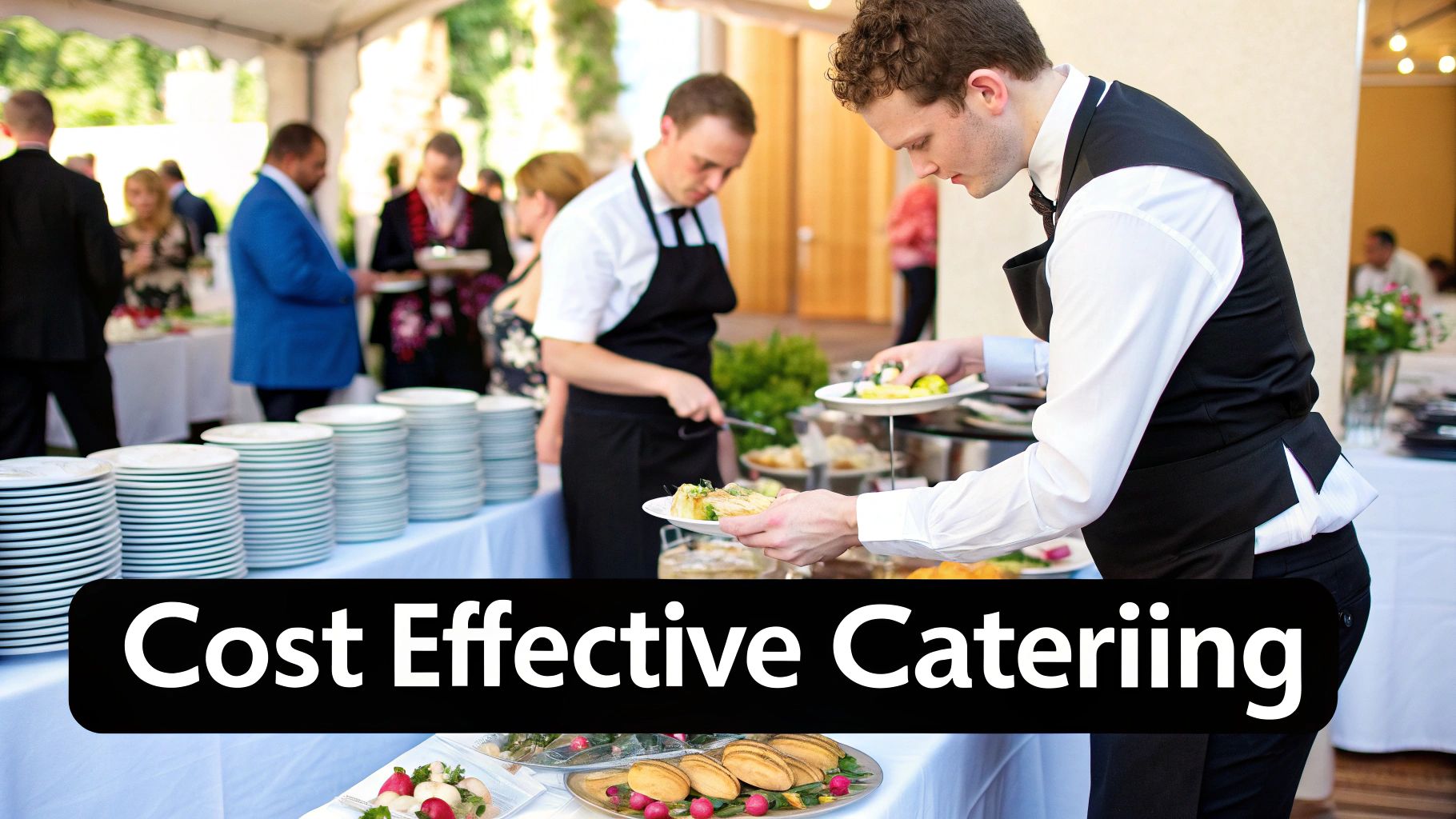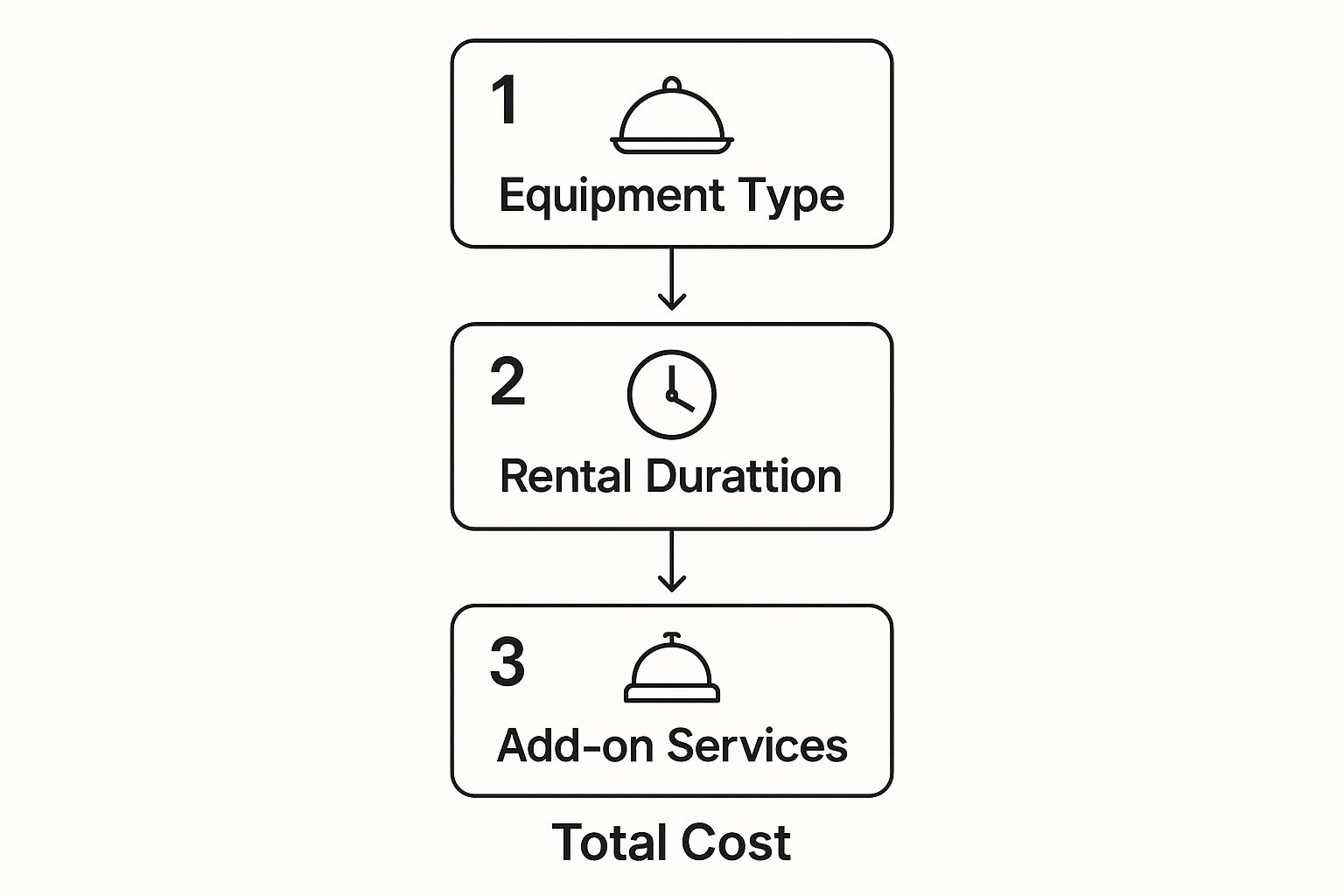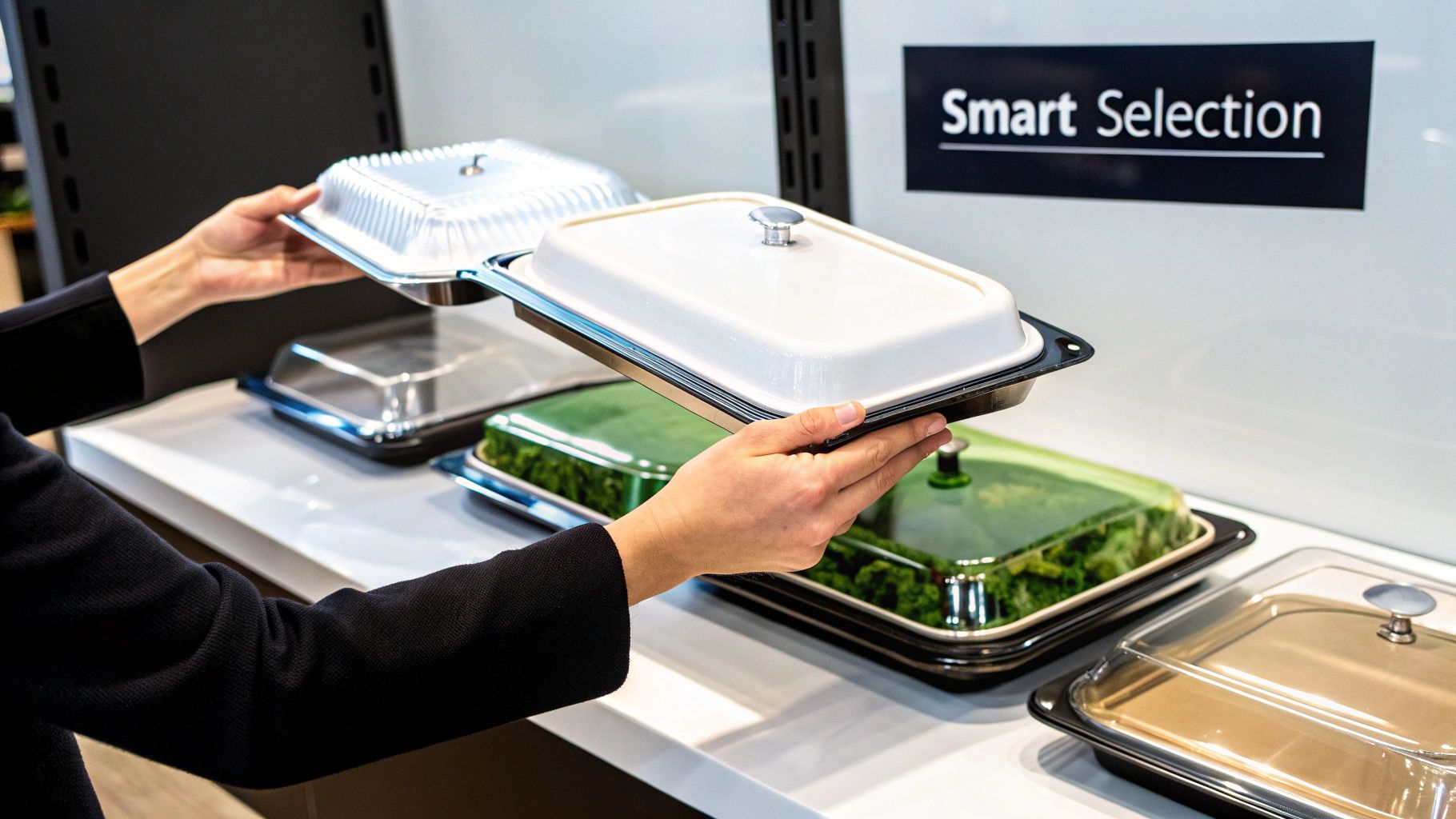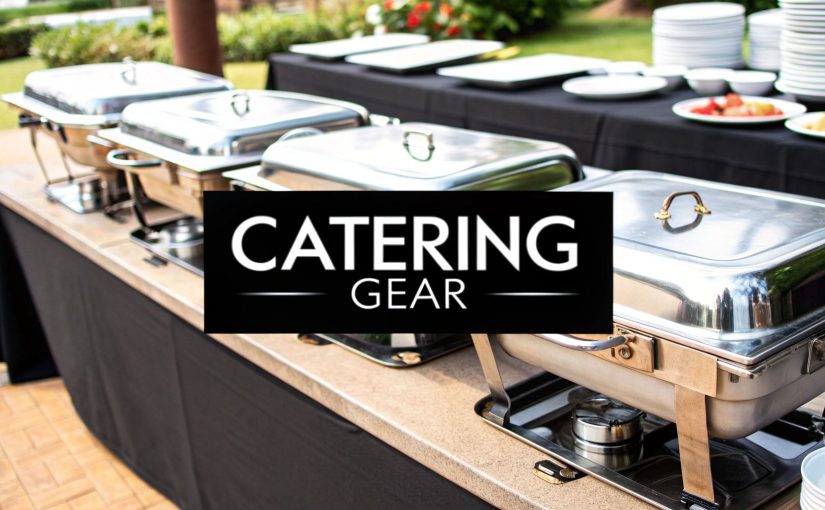Getting your catering equipment hire right starts long before you even glance at a rental catalogue. It all begins with a crystal-clear vision of what your event needs. When you match your culinary experience to the right gear from the get-go, you sidestep those nasty budget blowouts and day-of logistical nightmares.
Matching Your Event Vision to Equipment Needs
Before you hire a single chafing dish, you have to align your event’s vision with your equipment list. This isn’t just about counting heads; it’s about mapping out the entire culinary journey you want to create for your guests. Every single decision, from the menu you design to the service style you choose, has a direct impact on the hardware you’ll need on the day.
Think about it this way: a rustic, outdoor spit-braai for 200 guests has a completely different set of needs than an intimate, plated dinner for 50 in a formal venue. The spit-braai demands robust, portable cooking gear, a reliable power source, and cold storage that can handle the outdoors. The fancy dinner? That calls for elegant plate warmers, sophisticated serving platters, and maybe a mobile convection oven for those perfect finishing touches.
Assess Your Venue First
Your venue is the canvas for your event, and its existing infrastructure can either be a massive help or a major hurdle. A thorough walk-through will show you potential bottlenecks and hidden needs you might not have considered.
Before you finalise that rental list, get answers to these questions:
- Power Supply: Are there enough accessible plugs? Will you need to bring in a heap of extension cords, or even a generator for an outdoor setup?
- Kitchen Access: Is there a proper prep area, or are you basically building a temporary kitchen from scratch? Don’t forget to measure doorways and service lifts to make sure big items like fridges can actually get inside.
- Water Source: Find the taps and check for drainage. This is non-negotiable for both cooking and clean-up.
- Layout and Flow: Walk the path from the kitchen to the service area. This little exercise will tell you if you need extra service trolleys or mobile warming stations to keep things running smoothly.
A classic mistake is just assuming a venue has enough power for commercial-grade equipment. Always, always confirm the amperage of the circuits you plan to use so you don’t end up tripping the breakers right in the middle of service.
Thinking through these nitty-gritty details helps you build a solid checklist that anticipates problems before they happen. For a more structured approach, our comprehensive event planning checklist template can guide you through every stage, ensuring nothing gets missed. This kind of systematic planning is what turns your creative vision into a concrete, actionable equipment plan—and that’s the secret to a flawless event.
Choosing the Right Gear for Your Menu

Think of your menu as the script for your event’s culinary story. The equipment? That’s your cast of actors. Getting this pairing right is absolutely crucial for a flawless performance. It’s about moving past a generic checklist and really connecting each dish to the specific hardware it needs to shine.
So, how do you do it? Simple. Walk through every dish’s journey—from the initial prep and cooking to how it’s held at temperature and finally served.
Are crispy, golden samosas the star of your canapés? A commercial deep fryer isn’t just a nice-to-have; it’s a non-negotiable. Or what about that decadent, warm chocolate sauce for dessert? A Bain Marie will be your best friend, keeping it perfectly smooth and ready to drizzle without a hint of burning.
This detailed approach saves you from the headache of over-hiring (and overspending) and ensures your team has exactly what they need. The right catering equipment for hire is like a silent partner, working hard behind the scenes so your food gets all the credit.
Matching Equipment to Culinary Style
Different menus demand completely different setups. It’s just that simple.
A lively, roaming tapas-style event needs a fleet of small induction burners for those interactive cooking stations, not to mention a mountain of elegant platters and maybe even a few mini-fryers. But if you’re hosting a hearty potjiekos competition, you’re looking at heavy-duty cast-iron pots, powerful gas burners, and rustic serving bowls.
Let’s look at a few common scenarios:
- Buffet Service: You’ll need the obvious things like chafing dishes and serving spoons. But don’t forget reliable food warmers to keep everything delicious for hours.
- Plated Dinner: This is a different ball game. Plate warmers are key, as are convection ovens that can finish multiple dishes at once. Service trolleys also make a huge difference in getting plates out efficiently.
- Live Food Station: This is all about the specialty gear. Think crepe makers, portable pizza ovens, or gas grills, depending on what you’re serving up.
South Africa’s incredible culinary scene, with its blend of traditional and modern flavours, means we need equipment that can keep up. The local equipment rental market is a massive support system for our industry and set to grow.
Here’s a pro tip: Never forget the “holding” phase. Your chefs can cook the most amazing food, but it’s worthless if it’s cold by the time it gets to a guest. Quality hot-holding cabinets or insulated food transport boxes are an absolute game-changer.
At the end of the day, the best strategy is to break down your menu item by item. It might feel tedious, but this granular approach guarantees you won’t be scrambling for a whisk or wishing you’d hired one more oven on the day of the event.
For a deeper look into keeping every dish at its ideal temperature, check out our guide on choosing the right catering food warmers.
Budgeting and Vetting Rental Companies

Finding the right catering equipment for hire always comes down to a careful balance between quality and cost. A smart budget isn’t just about the itemised fees on a quote; you’ve got to look at the total cost of bringing that supplier on board.
Think about all the potential extras. Many companies will charge for delivery and collection, and you can bet those costs will creep up for weekends or after-hours service. It’s also a good move to factor in a damage waiver or a deposit. It’s a small price to pay for peace of mind when things get hectic.
These seemingly little charges can stack up fast, turning what looked like a great deal into a budget-busting surprise. Always, always ask for a fully itemised breakdown so you can see exactly where every rand is going.
Questions to Ask Before You Sign
Once you’ve got a few quotes lined up, it’s time to dig a little deeper. Price is a big deal, of course, but reliability? That’s everything. A supplier with dodgy equipment or zero support can bring your whole event grinding to a halt.
Before you sign on the dotted line, you need clear answers to a few non-negotiable questions:
- Maintenance and Hygiene: How often do you service and deep-clean your gear? You’ll want to know their exact sanitisation process, especially for anything that touches food.
- Emergency Support: What’s the plan if an oven gives up mid-service? A solid company will have an emergency number and a strategy for getting a replacement to you—fast.
- Delivery and Collection: What are the standard delivery windows? Crucially, will their team place the equipment where you need it, or just leave it at the door for you to lug around?
A supplier’s willingness to talk openly about their maintenance and emergency plans says a lot about their professionalism. If you get vague answers, see it as a major red flag. It could be a sign of trouble waiting to happen.
For many up-and-coming caterers, rental finance options are a fantastic way to get your hands on top-tier equipment without a massive upfront cost. This approach lowers the barrier to entry and really helps small businesses grow and compete on quality. You can learn more about how rental finance can support your catering business and take things to the next level.
Getting Your Rental Contracts and Bookings Sorted
So, you’ve found a few promising suppliers. Now it’s time to move from chats to contracts and lock in your catering equipment for hire. A handshake or verbal agreement just won’t cut it in the events world; a solid, detailed rental contract is your best friend. It’s the only way to protect yourself (and the hire company) from crossed wires and last-minute panics.
First things first, get a comprehensive, itemised quote. Don’t just accept a single figure at the bottom of an email. You need a full breakdown of every single cost – delivery fees, after-hours collection charges, damage waivers, the lot. Going through this with a fine-tooth comb is your best defence against nasty surprises that can blow your budget. It’s also your first real chance to make sure everything you’ve discussed is down in black and white.
Don’t Skip the Fine Print
Before you sign anything, read every single clause of that rental agreement. I mean it. Pay extra attention to the sections on liability, cancellations, and logistics. For example, what’s the plan if a fridge gives up the ghost mid-service? The contract needs to spell out exactly what the company’s responsibility is and how quickly they can get a replacement to you.
Pro Tip: Always get the delivery and collection times confirmed in writing. A vague promise of “sometime on Friday morning” is a classic recipe for stress. A truly professional outfit will give you a specific, narrow window and stick to it.
Understanding the cancellation policy is just as crucial. Things happen, events get postponed. Knowing exactly what the financial penalties are upfront means you can make a clear-headed decision if your plans have to change.
This infographic gives you a quick visual on how all the moving parts come together to form your final rental cost.

As you can see, it’s a mix of the equipment you choose, how long you need it for, and any extra services you add on. No hidden mysteries, just clear, transparent pricing.
Managing On-Site Logistics and Post-Event Returns

The success of your event now boils down to what happens on the ground. This is where you manage the day-of delivery and post-event returns with professional precision, ensuring everything runs without a hitch. A smooth process here not only keeps your service seamless but also keeps your supplier relationships strong for the future.
When your catering equipment for hire arrives, don’t just scribble a signature on the delivery note. Treat it like a proper check-in. Get your inventory list out and physically count and inspect every single item.
Plug in appliances to make sure they’re working, check that everything is clean, and make a note of any pre-existing scuffs or dings. Trust me, this small step can save you from massive headaches and potential deposit disputes down the line.
Setting Up for Success
Once everything is checked in and accounted for, it’s time to create an efficient workflow in your temporary kitchen. Think like a chef and set up distinct zones for different tasks—it’s the best way to prevent chaos when the pressure is on.
- Prep Zone: This is where the chopping, mixing, and initial assembly happens. Keep it clean and organised.
- Cooking Line: Arrange ovens, fryers, and grills in a logical flow that matches your menu.
- Plating and Service Area: Designate a clear space for that final touch before the dishes head out to your guests.
- Dirty Returns: Have a dedicated spot for used plates and cutlery, keeping it well away from your clean zones.
The party equipment rental market is part of a massive global industry. It thrives by offering comprehensive services like delivery and setup. By organising your on-site space effectively, you’re getting the absolute most out of that convenience. You can discover more insights about the party equipment rental market on DataHorizzon Research.
A professional wrap-up is just as important as the event itself. Don’t let a messy breakdown tarnish a perfectly executed function. It shows respect for both the equipment and the supplier.
The Post-Event Teardown
After the last guest has said their goodbyes, the job isn’t quite over. The first thing to do is follow the rental company’s cleaning guidelines—this usually just means scraping plates and rinsing items. Then, repack everything carefully into its original containers.
If any accidental damage happened during the event, document it immediately with a few photos and let the supplier know. Honesty is always the best policy and builds trust.
A smooth collection process solidifies your reputation as a professional, paving the way for easy future hires. This same level of logistical care is essential when you’re renting furniture for events, ensuring every element of your setup is managed perfectly from start to finish.
Common Questions About Catering Equipment Hire
When you’re deep in the logistics of planning an event, questions about hiring catering equipment are bound to pop up. Getting clear, straightforward advice helps you hire with confidence and sidestep the usual pitfalls. Here are the answers to some of the most frequent questions we hear from planners and caterers on the ground.
How Far in Advance Should I Book?
The golden rule? Lock it in as soon as your event date and menu are confirmed. This is especially true for those high-demand dates, like the December holidays, or if you’ve got your eye on specialty items.
For most events, booking 4-6 weeks in advance is a safe bet. But if you’re planning a massive function during peak season, it’s smart to get your equipment sorted 2-3 months out. This doesn’t just guarantee you get what you need; it often helps you lock in better pricing before the last-minute rush hits.
What Happens If Equipment Fails?
This is exactly why you need to vet your supplier properly. Any hire company worth its salt will give you an emergency contact number for on-the-day support.
Before you sign on the dotted line, get crystal clear on their policy for equipment failure.
- Do they offer immediate replacements for faulty gear?
- Is there a technician on call who can actually help?
- What’s their promised response time for an emergency?
Knowing their support plan gives you crucial peace of mind and acts as a safety net for your event.
A supplier’s emergency plan tells you everything you need to know about their professionalism. Vague promises are a red flag—you need a concrete plan you can count on when a critical service moment goes sideways.
Who Is Responsible for Cleaning?
This is one of those details that can vary quite a bit between companies, so always check the specifics in your rental agreement. Generally, the standard expectation is that you’ll scrape off any food and give the items a decent rinse after use.
The hire company then handles the heavy-duty, final sanitisation back at their warehouse. Some suppliers will also offer a full cleaning service for an extra fee, which can be a real time-saver during a frantic event breakdown.
Do I Need Insurance for Hired Equipment?
Most hire companies include a standard damage waiver in their contracts. This usually covers normal wear and tear from use. However, you will almost always be held liable for any significant damage, loss, or theft of the equipment while it’s in your care.
Make sure you review the liability clause in your contract with a fine-tooth comb. It’s also a good idea to check if your own business or event insurance policy offers any extra coverage. Being fully informed upfront means you won’t be hit with an unexpected—and expensive—bill after your event is over.
Ready to equip your next event for success? The team at ABC Hire offers a premium selection of reliable, high-quality catering and event equipment to bring your vision to life. Explore our extensive inventory and get a quote today at https://abchire.co.za.

